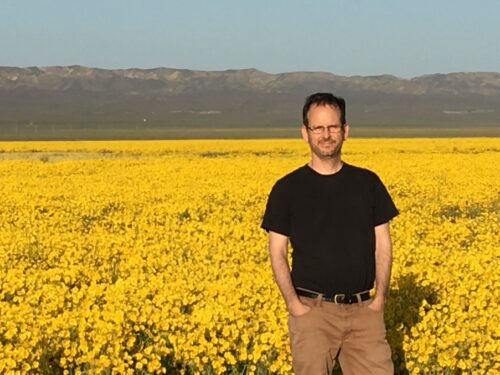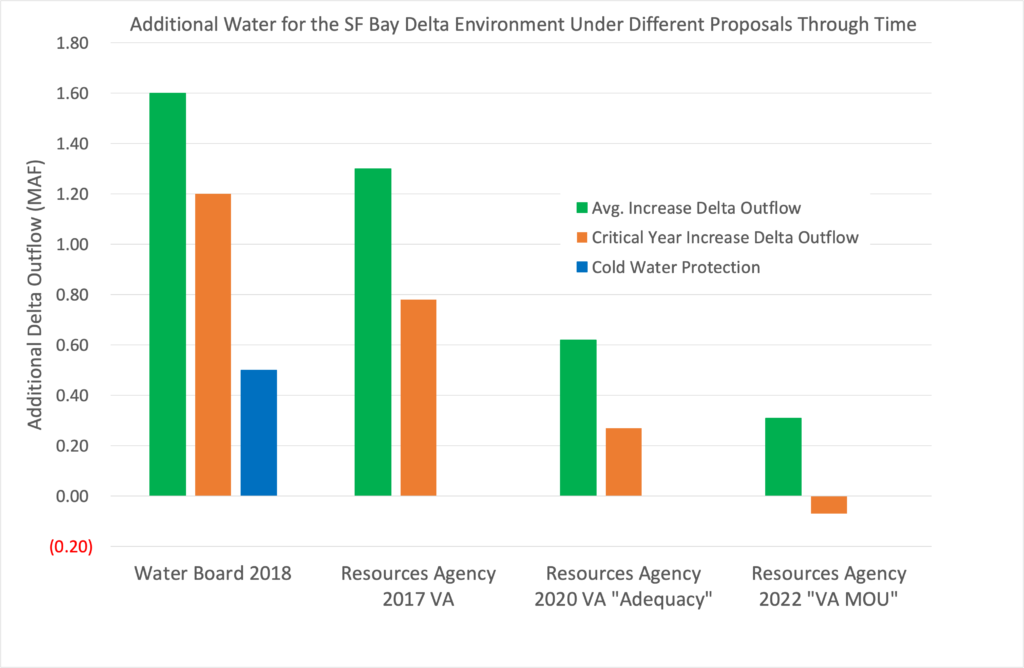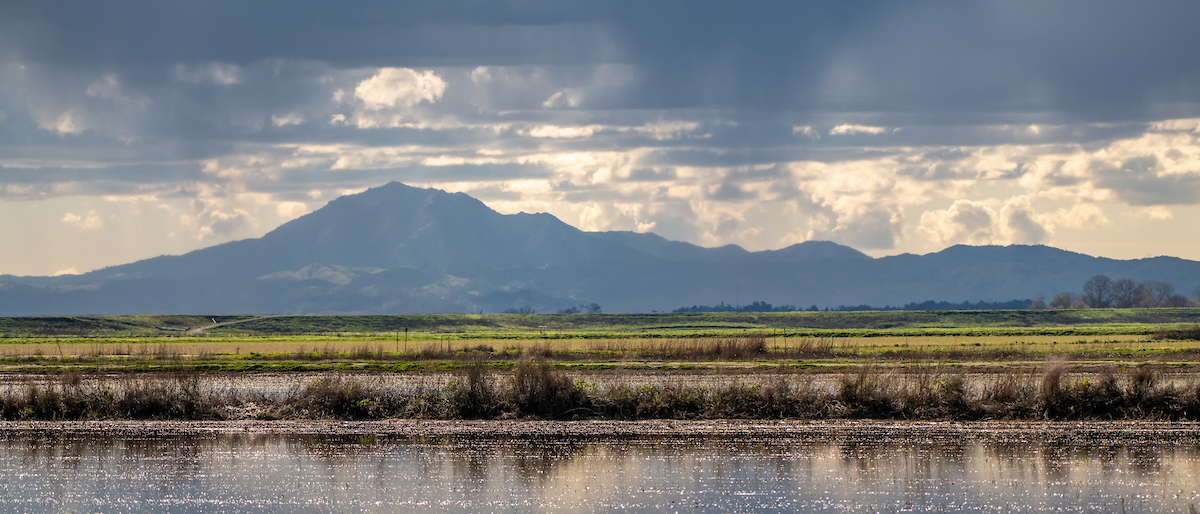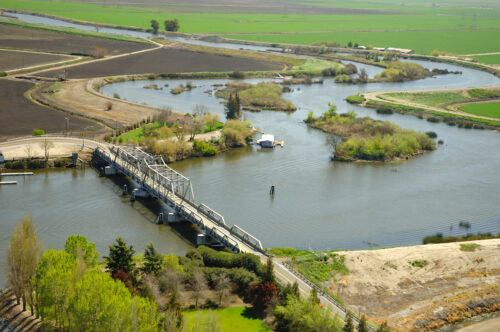 After completing degrees from Cornell University, University of Michigan, and the University of New Mexico, Dr. Jon Rosenfield returned to the Bay Area in 2002, where he worked as a postdoctoral researcher in the laboratory of Dr. Peter Moyle. He researches and is a tireless advocate for the Central Valley’s native salmon, steelhead, and smelt species. Dr. Rosenfield went on to The Bay Institute where he worked for over ten years to protect fisheries, becoming one of the region’s leading experts on the importance of freshwater flows from the Delta for the sustainability of the Bay’s ecosystem and fish populations. He is now a Senior Scientist at San Francisco Baykeeper, a position he has held since 2019. I asked him questions about the Delta Conveyance Project, the Voluntary Agreements, and what he is working on at the Baykeeper.
After completing degrees from Cornell University, University of Michigan, and the University of New Mexico, Dr. Jon Rosenfield returned to the Bay Area in 2002, where he worked as a postdoctoral researcher in the laboratory of Dr. Peter Moyle. He researches and is a tireless advocate for the Central Valley’s native salmon, steelhead, and smelt species. Dr. Rosenfield went on to The Bay Institute where he worked for over ten years to protect fisheries, becoming one of the region’s leading experts on the importance of freshwater flows from the Delta for the sustainability of the Bay’s ecosystem and fish populations. He is now a Senior Scientist at San Francisco Baykeeper, a position he has held since 2019. I asked him questions about the Delta Conveyance Project, the Voluntary Agreements, and what he is working on at the Baykeeper.
Question 1: What is the biggest issue facing the Delta and what should the state be doing about it?
The biggest threat to the Delta ecosystem is the unsustainable diversion of river flows both upstream and from the Delta itself. We need updated, science-based, water quality standards that protect native fish and wildlife species, and the people who rely on and enjoy a vibrant San Francisco Bay estuary, which includes the Delta.
Decades of scientific research shows that chronically low river flows are the primary driver of declines in fish, wildlife, and water quality in the Delta and San Francisco Bay. The viability of many fish and wildlife populations is strongly and positively correlated with the volume of river flow into and/or out of the Delta. This includes endangered species, but also non-endangered fish that people depend on for sustenance, recreation, and jobs. At the same time, toxic algal blooms, invasive predators, and aquatic weeds all thrive in the slow-moving, warm water conditions that persist when too much water is diverted.
My collaborators at the Bay Institute, the Nature Conservancy, and I documented that less than half of the winter-spring runoff from snow and rain in the Central Valley watershed now reaches San Francisco Bay in an average year (and even less in dry years) because of unsustainable water diversion. This percentage has continued to decline over time, so now less rain and snowmelt runoff flows through the Delta than even a few decades ago.
The state should update the water quality objectives in its Bay-Delta Water Quality Control Plan (“Water Quality Plan”) to ensure that enough water makes it from the mountains to San Francisco Bay to support public fisheries and clean water for everyone. This update must also include new, science-based water temperature safeguards to protect salmon spawning below reservoirs upstream of the Delta. State and federal laws require the State Water Resources Control Board (“Water Board”) to review the Water Quality Plan every few years, but it hasn’t completed a review since 2006. A partial update to water quality standards was adopted in 2018, which revised standards for Delta inflow from the San Joaquin River. But the Water Board has not held diverters responsible for attaining these new standards, so there has been no improvement in flow conditions.
The Newsom administration has blocked the completion and implementation of improved Delta water quality standards, and the regulations it adopted under the California Endangered Species Act are woefully inadequate. Instead, Newsom has pursued voluntary agreements (“VAs”) with water diverters that have thus far failed to produce meaningful protections for the Bay-Delta watershed.
Question 2: The state recently released an MOU for a voluntary agreement for the Sacramento Valley that promises water and habitat restoration. What do you think of this agreement? Is it enough? What do you think it would take for a voluntary agreement to be successful?
In March, the state emerged from closed-door negotiations with large water districts to announce a memorandum-of-understanding (MOU), which is an agreement to agree in the future. Many of the parties that would need to contribute water under this MOU did not sign it, including all the water districts along the San Joaquin and Mokelumne Rivers. Most other interested parties—including tribes, fishermen, Delta communities, and environmental protection NGOs—were excluded from these negotiations. The MOU lacks credibility, even in its limited scope as the framework to make future plans for a VA.
The substance of the MOU framework is also unacceptable. Newsom’s team acquiesced to utterly inadequate flows into and through the Delta, and ignored other measures necessary to protect fish and wildlife. In fact, compared to past VA proposals, the Newsom administration appears to be negotiating against itself.
In 2010, the Water Board reviewed a massive amount of research and public testimony and concluded that “The best available science suggests that current flows are insufficient to protect public trust resources.” It projected that an additional several million acre-feet (MAF) of water would need to flow through the Delta to San Francisco Bay to protect the public trust. In 2018, after balancing the needs of the environment against consumptive uses of water, the Water Board proposed standards that, combined with the updated San Joaquin River standard, would lead to additional Delta outflow of about 1.6 MAF on average and 1.2 MAF in critically dry years (Figure 1). In addition, they proposed adopting water export rules to protect endangered fish and reservoir storage requirements upstream (amounting to about 0.5 MAF) in order to protect cold-water reserves for spawning salmon.

California’s Natural Resources Agency (“Resources”) and CalEPA have been pretending the Water Board’s scientific findings, proposals, and its updated San Joaquin River flow standard do not exist. In 2020, Resources suggested it would accept a VA that resulted in as little as 0.62 MAF on average and about 0.27 MAF in a critical year. That proposal was silent on the need for additional export restrictions to protect fish, and included no new storage requirements for upstream reservoirs.
 In their recent MOU, Resources and CalEPA agreed to accept even less Delta outflow than what they identified as adequate in 2020. Worse, in critically dry years, the MOU would result in less Delta outflow than would have occurred under previous rules (Figure 1). Prior VA proposals and the Water Board’s 2018 framework were intended to increase flows beyond what would occur under the 2008/2009 biological opinions for endangered species in the Delta. However, the state used the Trump-era 2019 biological opinions as its basis for evaluating the MOU. This is bizarre because the state argued in court that those biological opinions –which increased water exports and reduced Delta outflows substantially– were inadequate and illegal. Nevertheless, Resources and CalEPA contrasted their MOU to the Trump-era baseline because that’s the only comparison under which the MOU would look like an improvement. An apples-to-apples comparison, where all proposals are assessed relative to the same (2008/2009 biological opinion) baseline shows that the MOU would lead to far less additional Delta outflow than previous proposals and a net reduction in outflow during critically dry years (Figure 1).
In their recent MOU, Resources and CalEPA agreed to accept even less Delta outflow than what they identified as adequate in 2020. Worse, in critically dry years, the MOU would result in less Delta outflow than would have occurred under previous rules (Figure 1). Prior VA proposals and the Water Board’s 2018 framework were intended to increase flows beyond what would occur under the 2008/2009 biological opinions for endangered species in the Delta. However, the state used the Trump-era 2019 biological opinions as its basis for evaluating the MOU. This is bizarre because the state argued in court that those biological opinions –which increased water exports and reduced Delta outflows substantially– were inadequate and illegal. Nevertheless, Resources and CalEPA contrasted their MOU to the Trump-era baseline because that’s the only comparison under which the MOU would look like an improvement. An apples-to-apples comparison, where all proposals are assessed relative to the same (2008/2009 biological opinion) baseline shows that the MOU would lead to far less additional Delta outflow than previous proposals and a net reduction in outflow during critically dry years (Figure 1).
Like prior VA proposals, the MOU fails to require protection of cold water upstream, or to include terms that will limit the number of endangered fish entrained in Delta exports.
Question 3: The Delta Conveyance Project will soon release environmental documents for public review. The state says the downsized project will help capture water from the large storm events, be more protective of species, and has been rerouted to minimize impacts to Delta communities. What’s your take on the Delta Conveyance Project?
We’ll need to see what they propose; the devil is in the details. The state’s primary argument for tunnels under the Delta has always been that the status quo is unacceptable. We agree. But, simply changing the plumbing does not deal with the fundamental problem that we divert too much river flow before it reaches the Delta and San Francisco Bay. Previous Delta tunnel proposals would have diverted more water, not less. Even our unacceptable status quo can be made worse by a poorly conceived “solution” that ignores the underlying problem: unsustainable demand for water.
Any new Delta conveyance must be governed by operational rules that ensure more water flows through the Delta. This is why we need the Water Board to update its antiquated and obviously inadequate flow standards. The Water Quality Plan should set the boundaries for the operation of the Delta Conveyance, not the other way around. The Delta Reform Act established several goals, including increasing the reliability of our water supplies, improving protections for the Delta ecosystem, reducing reliance on Delta water supplies, and enhancing the unique values of the Delta as an evolving place. We’ll be looking to see whether the Department of Water Resources’ Delta Conveyance proposal is faithful to all of these policy goals.
Question 4: Are you optimistic or pessimistic for the Delta’s future? What do you think is achievable for the Delta?
 On the one hand, I’m optimistic for the Delta because California and US voters have repeatedly and strongly supported protection of our aquatic ecosystems and favored passage of laws such as the Clean Water Act (state and federal), Endangered Species Act (state and federal), Central Valley Project Improvement Act, and Delta Reform Act. And, we have abundant and compelling scientific evidence that restoring the natural timing and magnitude of river flows is necessary to protect a wide range of fish and wildlife species, as well as to improve water quality for everyone.
On the one hand, I’m optimistic for the Delta because California and US voters have repeatedly and strongly supported protection of our aquatic ecosystems and favored passage of laws such as the Clean Water Act (state and federal), Endangered Species Act (state and federal), Central Valley Project Improvement Act, and Delta Reform Act. And, we have abundant and compelling scientific evidence that restoring the natural timing and magnitude of river flows is necessary to protect a wide range of fish and wildlife species, as well as to improve water quality for everyone.
On the other hand, I’m pessimistic that California’s leaders will voluntarily set us on a course to water sustainability before it’s too late. As the blogger On the Public Record said recently: “Our leaders do not have the courage and vision to fix this”. It is not even clear that the governor and his lieutenants understand the depths of inequity and injustice in our system of allocating the state’s water; they seem fully committed to letting our water future be dictated by those who profit from the unsustainable use of California’s water.
Question 5: What projects have you been working on at the San Francisco Baykeeper?
A lot of my time is occupied by tracking emerging science on the forces that affect our native fish and wildlife. I also direct Baykeeper’s research into the effects sea level rise will have on toxic sites around the Bay’s shoreline. Recent research out of UC Berkeley suggests that even previously remediated toxic sites are at risk of rising groundwater levels, driven by sea level rise. This is a ticking time bomb that the state and municipalities need to address immediately.
We’re also using drone technology—in collaboration with Restore the Delta, Little Manila Rising, state agencies, and university researchers—to document the frequency and distribution of toxic algal blooms in the Delta.




